#Luigi Petroselli
Text
io voto, tu voti (pci) / giorgio ferrara. 1981
io voto, tu voti (pci) / giorgio ferrara. 1981
IO VOTO, TU VOTI (PCI)
Scheda integrale: https://goo.gl/tjSyuj
Regia: Giorgio Ferrara
Casa di produzione: Unitelefilm
Anno: 1981
Abstract: Docu-fiction realizzato dal Pci per le elezioni comunali del 1981. Tre giovani (Franco Citti, Ninetto e Pier Paolo Davoli) vagabondano per Roma e scoprono una città migliorata grazie alle opere realizzate dalle amministrazioni di sinistra.
Archivio Audiovisivo…
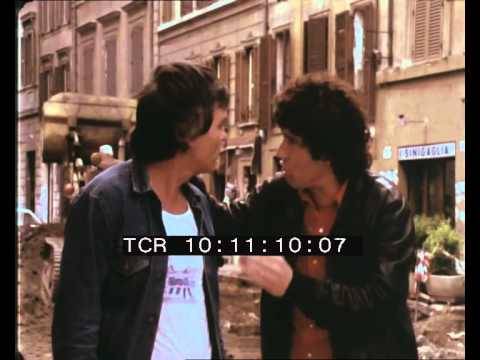
View On WordPress
#AAMOD#Archivio Audiovisivo del Movimento Operaio e Democratico#docu-fiction#docufiction#documentario#Franco Citti#Giorgio Ferrara#Io voto tu voti#Luigi Petroselli#Metropolitana#Ninetto Davoli#PCI#Pier Paolo Davoli#Roma#Unitelefilm
0 notes
Text
[in progress] Renato Nicolini, Estate romana
random article
Per capire la portata dell’Estate Romana bisogna contestualizzare e capire che città fosse la Roma di Nicolini. Era, in primis, una città in cui il centro era vissuto in maniera tangenziale dai cittadini, relegato più a luogo di lavoro che a una parte della città da vivere a pieno, soprattutto per gli abitanti delle borgate. In secondo luogo era una città poco sicura, nel pieno degli anni di piombo, proprio in quell’anno veniva arrestato per la seconda volta il brigatista Renato Curcio e, solo due anni dopo, sarebbe stato sequestrato Aldo Moro. Anche a causa di questo la vita culturale della città era molto scarsa e soprattutto divisa per fasce, ad una situazione culturale molto elitaria il ceto meno abbiente rispondeva con la stagione delle cantine e dei cineclub, un circuito sotterraneo di diffusione della cultura.
Non è il luogo che fa l’evento ma sono le persone che lo frequentano a dargli uno scopo, l’utopia della modificazione della città si realizza attraverso il non costruito, il non pianificato, e apre la stagione dell’effimero, che durerà per tutta la permanenza di Nicolini all’assessorato. Nonostante lo stesso Nicolini non apprezzasse questa terminologia, ma preferisse parlare di Meraviglioso urbano, il dibattito intorno all’Estate Romana si mosse intorno a due poli che discutevano dell’utilità o meno di una politica effimera.
Perchè costruire con i mattoni indirizza un’esperienza, e l’innovazione portata da Nicolini è stata la comprensione di questo processo e la volontà di lasciare che questa esperienza fosse governata da una struttura immateriale, sostanzialmente dal convergere insieme di una comunità in un determinato luogo, aprendo a delle possibiltà anche differenti da quelle che offre la pianificazione urbana tradizionale. Nella Roma di Nicolini l’effimero era un ventaglio di opportunità, la parte di un’utopia che temporaneamente può essere messa in atto.
Oggi che Nicolini è stato mitizzato e in tanti, un po’ ovunque, si proclamano indebitamente custodi della sua eredità, è necessario ricordare che l’Estate Romana non fu solo uno schermo cinematografico tra i monumenti bensì un vero e proprio manifesto urbanistico, culturale e, perché no, architettonico. Nulla a che vedere insomma con un banale concerto ai Fori Imperiali o le orribili bancarelle sulle rive del Tevere né tantomeno le recenti porcherie rock sul Palatino. Cercando di non cadere nelle insidie agiografiche indotte dalla desolante contemporaneità dobbiamo dunque sottolineare che la grandezza di quella stagione fu ben altra dalla movida di oggi e le differenze sono chiare se analizziamo le edizioni successive.
Archivio Luce
1976: A Roma fu eletto sindaco lo storico dell'Arte Giulio Carlo Argan, che tre anni più tardi lascerà il posto a Luigi Petroselli. Ma chi cambiò veramente il volto della città fu un giovane architetto che venne nominato assessore alla cultura, Renato Nicolini, del quale ricorrono in questi giorni i dieci anni della scomparsa.
Fino a quel momento per chi, per diverse ragioni, era costretto a restare in città, luglio e agosto erano mesi in cui non c'era nulla da fare: cinema e teatri chiudevano, concerti non ce n'erano tanti e comunque non alla portata di tutti. Nasce da questi presupposti l'Estate romana che dal 1977 caratterizzerà i mesi estivi dei romani: musica, cinema, avanguardie. E poi periferie dove finalmente si inizia a fruire la cultura.
Rai post-pandemic video on 1977 Estate Romana
Estate romana Wikipedia
l'intento di indurre i cittadini romani a usufruire degli spazi pubblici della metropoli in risposta all'emarginazione delle periferie prendendo spunto dall'enorme domanda di convivialità e richiesta di cultura, dai “nuovi bisogni” provenienti dal basso
In molti quartieri della città venivano organizzati autonomamente eventi del genere che raccoglievano una grande adesione popolare. L'estate romana ruppe il diaframma dei ghetti urbani aprendo il centro storico della città alle periferie. La politica culturale promossa da Nicolini andava in controtendenza con una storica abitudine italiana di forte accentramento della cultura e di divisione classista dell'accesso al sapere
musica pop e avanguardia, balletto, teatro di strada, maratone cinematografiche di film popolari e d'autore, giocando sulla contaminazione delle pratiche di "cultura alta" e "cultura bassa"
alle rassegne dell'Estate Romana partecipa una varietà di platee di diverse estrazioni sociali, dagli intellettuali agli studenti, dagli abitanti del centro storico alle masse popolari della periferia cittadina
La manifestazione fa il suo esordio con alcuni spettacoli cinematografici presso la Basilica di Massenzio organizzati dal comune in collaborazione con alcuni cineclub della capitale. Lo schermo di Massenzio si accende il 25 agosto 1977 con la proiezione del film Senso di Luchino Visconti, di fronte ad alcune centinaia di spettatori. Nei giorni successivi l'affluenza cresce vertiginosamente: la proiezione su quattro schermi in simultanea e le prime maratone di film portano a Massenzio migliaia di spettatori entusiasti.
La risposta formulata da Nicolini e dai suoi collaboratori all'avvenuta impossibilità di riduzione a schemi organici del sistema sociale intende proporre a un'aggregazione massificata e trasversale grandi eventi culturali privati della tradizionale "aura" che in passato contraddistingueva le espressioni della cultura alta. Il profilo all'apparenza "leggero" delle manifestazioni romane contiene in sé la ricerca di una dimensione politica alternativa in grado di conseguire "non tanto la prefigurazione di un avvenire ipotetico possibile, la formulazione di modelli di società virtuosa, ma la capacità di scegliere quegli elementi che sono in grado di produrre movimento, di formulare nuove ipotesi, di rinnovare la cultura e la politica stessa" (Renato Nicolini, intervento alla tavola rotonda L'effimero e la cultura di massa, 1982).
A questo bisogno di cultura si sovrappone un corrispondente desiderio di socializzazione; da parte di larghe fasce di pubblico, in particolar modo giovanile, emerge la forte esigenza di recuperare il piacere dell'aggregazione di massa. Una voglia di socialità messa in discussione dall'assenza di offerte culturali di massa, di luoghi di ritrovo nei quali la cultura sia anche partecipata, da una visione “lavorista” della vita che non concede spazio a momenti ludici o ritiene dispersiva la fruizione di cultura. Inoltre, dall'Estate Romana viene a galla la richiesta da parte di larghi strati metropolitani di poter fruire di spettacoli culturali non rigidamente sottoposti ai dettami del consumo commerciale.
Massenzio Wikipedia
Massenzio Architectuul
film screenings in the area around Domus Aurea

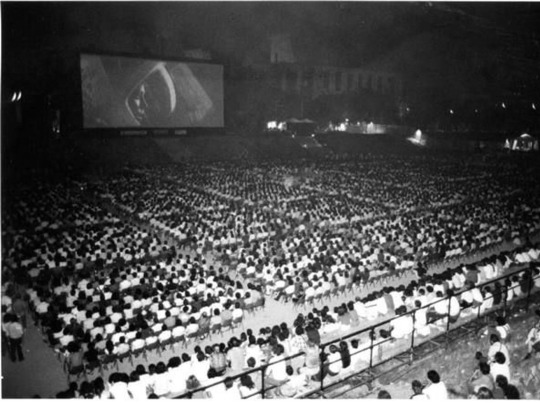
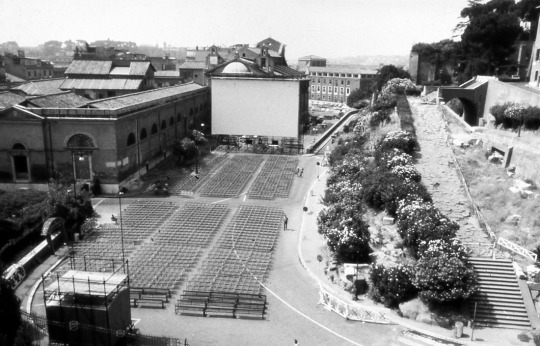

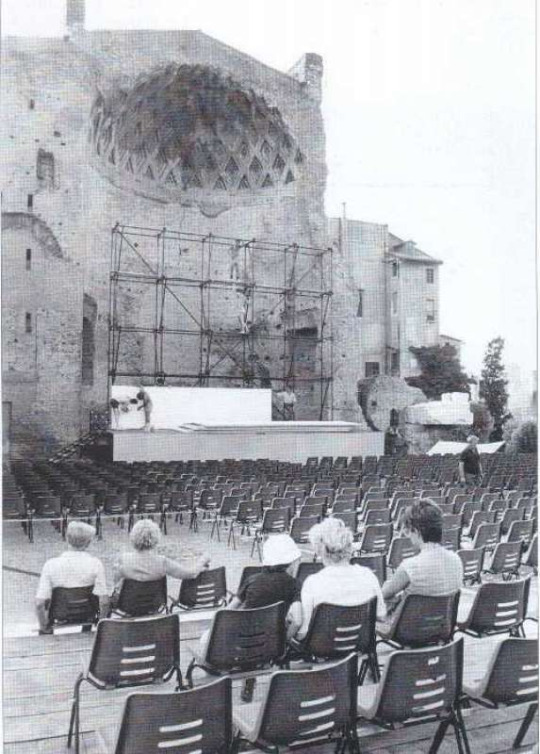
Renato Nicolini Wikipedia
Renato Nicolini Architectuul
Renato Nicolini Archinform
Book: Federica Fava: Estate romana. Tempi e pratiche della città effimera
Il meraviglioso urbano. L’Estate romana di Renato Nicolini
Dalla rassegna Cinema epico alla Basilica di Massenzio che, trasformando la sede estiva dei concerti dell’Accademia di Santa Cecilia – con le parole di Nicolini: “Luogo d’élite, riservato ai colti e dunque ai pochi” – in luogo per il cinema popolare, innesca l’incontro tra i pochi e i molti, all’ultima estate (1985) mirata alla riscoperta del paesaggio metafisico dell’Eur, passando per le visioni di Massenzioland, con uno straordinario Circo Massimo trasformato in città del cinema con proiezioni dal tramonto all’alba, e Parco Centrale, edizione “distribuita” su quattro location, ai limiti della scena urbana conosciuta. Il Mattatoio abbandonato a Testaccio, via Sabotino a Prati, il Parco della Caffarella e Villa Torlonia (ancora tutta da riconquistare) diventano i luoghi del teatro, della musica, della danza e del video, con allestimenti affidati a Franco Purini e Laura Thermes. Tra questi il Teatrino scientifico dedicato agli spettacoli teatrali e costruito su uno spazio liberato dalla demolizione di alcune case popolari e protetto dalla mobilitazione dei comitati di quartiere, esemplifica bene come questa città dell’effimero sia pensata come uno strumento di gestione pacifica del conflitto urbano, capace di costruire, attraverso l’arte e la cultura, luoghi di incontro piuttosto che di scontro. Il teatrino è infatti un dispositivo relazionale: uno spazio in cui il pubblico circondando la scena, vi entra dentro, diventa protagonista, si guarda.
random article
L’idea che un ‘borgataro’ – uno dei tanti cittadini romani residenti nelle borgate, aree urbane periferiche, satellite alla città stessa – potesse scoprire la maestosità del soffitto a lacunari di Massenzio, deve fornirci, con un po’ di immaginazione, l’iter interpretativo della portata epocale di quell’evento.
Book: Marco Testoni: Renato Nicolini -- La gioiosa anomalia
Nicolini e l’Estate romana delle contaminazioni
Invece che far prevalere la logica della paura, e cedere al rischio concreto di una militarizzazione della società, come egli stesso disse, si volle proporre un’estensione del diritto di cittadinanza, dicendo a ogni romano – per usare le sue semplici parole – «la città è tua, la puoi vivere in modo divertente, piacevole, non devi testimoniare nulla, non devi essere impegnato»: ne sei comunque di diritto cittadino.
right to the city
Le polemiche sulla politica culturale di Nicolini non si placarono, e nel 1981 si aprì un dibattitto, soprattutto da parte socialista, che contrapponeva il suo “effimero” – quelle iniziative immateriali che non lasciavano nulla se non un ricordo nella memoria dei partecipanti, secondo i detrattori – e il “permanente”: gli interventi strutturali di cui la città aveva bisogno (e che in verità, proprio quelle giunte avevano avviato con importanti risultati). Dopo la fine del suo assessorato, l’Estate romana venne dunque alquanto ridimensionata e, rispetto alle idealità che avevano animato quelle giunte, assai snaturata.
Quando Roma smette di meravigliare. Sulle (dis)ragioni della giunta cinquestelle di mettere fine all’Estate romana di Ottavia Nicolini
Tre sono stati, a mio giudizio, gli elementi decisivi che, cristallizzandosi tra di loro, hanno dato vita a quell’esperienza generazionale unica e irripetibile dell’Estate romana dal 1976 al 1985:
a) il suo carattere di novità
Con la rassegna cinematografica Cinema epico, svoltasi dal 25 Agosto al 18 Settembre 1977 “un luogo considerato di élite, riservato ai colti e dunque ai pochi” viene aperto, per la prima volta, a un pubblico più ampio che, attratto da un’offerta culturale variegata, entra, spesso per la prima volta, proprio nel suo centro storico, instaurando così un forte legame di appartenenza con la città e la comunità dei suoi abitanti. Il primo segreto dell’Estate romana ha poggiato dunque in prima istanza sulla possibilità di questo incontro inedito tra classi sociali diverse, in cui i gusti culturali invece di creare barriere hanno fatto da apripista, invitando le persone a interagire gli uni con gli altri invece che circoscrivere ognuno nel suo recinto abitativo e culturale. Quel mix sapientemente dosato di “cultura alta” e “cultura bassa” è riuscito a gettare un ponte tra immaginari sconosciuti, portando la periferia in centro e il centro in periferia. Anzi, direi di più, dissolvendo in qualche modo, anche se solo per una sera, la distinzione tra centro e periferia.
b) l’energia immaginativa che ha saputo sprigionare
Attraverso la proiezione notturna sul grande schermo resa possibile da allestimenti effimeri in luoghi inusuali della città si è andati a lavorare proprio sull’immaginario, evocando sogni e desideri nascosti in ognuna e ognuno di noi. Rivivere la grande città di notte, d’estate, in un tempo diverso da quello della routine quotidiana apre di per sé lo spazio urbano alla meraviglia, allo stupore di fronte all’inconsueto, all’altro da noi, a ciò che non si è ancora mai visto. Vedere al Colosseo su tre schermi costruiti appositamente il Napoleon di Abel Gance, un film muto della durata di 4 ore, accompagnato dall’Orchestra dell’Opera di Roma sotto una pioggerellina leggera è sicuramente un’esperienza rarefatta, al limite tra la realtà e l’immaginazione. E proprio questo senso di meraviglia che la comunità urbana può evocare è alla base di quell’esperienza del “meraviglioso urbano” con cui mio padre amava descrivere quell’incontro inaspettato tra la città, i suoi luoghi e i suoi abitanti che è anche un incontro/scontro di sogni, aspettative, progetti, opinioni e punti di vista che rendono viva la comunità urbana.
visioni urbanistiche capaci di modificare poi di fatto non solo l’immaginario personale di ognuna e ognuno di noi ma anche la composizione urbana della città stessa. Ricordiamo infatti che dopo il successo di Massenzio al Colosseo è stata pedonalizzata l’area accanto al Colosseo, togliendolo alla sua funzione di rotatoria spartitraffico così come in seguito alla creazione di parco Centrale a via Sabotino è stata impedita l’ennesima speculazione edilizia per destinare l’area a parco pubblico.
c) quella che si potrebbe definire come la creazione di una cittadinanza pubblica felice
l’attivazione di una esperienza culturale di felicità pubblica che è stata in grado di creare una comunità di cittadine e cittadini innamorati della propria città, andando oltre il concetto di mera cittadinanza. L’esperienza dell’Estate romana è diventata un’esperienza generazionale proprio perché ha permesso di sperimentare insieme una forma di “felicità pubblica”, di “appartenenza gioiosa” alla città di Roma nel suo complesso
Una sera d’estate, una sera di gioia, una sera in fondo dove tutto è possibile e in cui si guarda avanti, fiduciosi in un futuro prossimo che ancora non è arrivato ma che arriverà.
editions, locations
1977-78
quasi esclusivamente cinema, Basilica del Massenzio
1979
Parco Centrale -- Città della Musica all’ex Mattatoio, Città della Danza alla Caffarella, Cittá della Tv a Villa Torlonia, Teatro Scientifico di via Sabotino
Festival Internazionale dei Poeti, Castel Porziano
1980
schermo nell'area archeologica -- Fori Imperiali, Colosseo, via della Consolazione
fuori le macchine
Ugo Colombari e Giuseppe De Boni da allora in avanti diventeranno gli “architetti dell’Estate Romana”
1981
schermo nel Colosseo
Anfiteatro Flavio fuori le macchine
1982-84
Circo Massimo
le splendide mostre al Palazzo delle Esposizioni con i suggestivi allestimenti di Maurizio di Puolo prima e Costantino Dardi poi
31 dicembre 1982
capodanno galleria di via del Tritone
1985
Attraverso il più maturo, e per certi versi più suggestivo, allestimento di Colombari e De Boni la prospettiva dechirichiana di via della Civiltà e del Lavoro venne negata dallo schermo che occludeva completamente la strada creando una nuova, straniante, chiave di lettura per quei luoghi.
la mostra Avanguardia-Transavanguardia curata da Achille Bonito Oliva
youtube
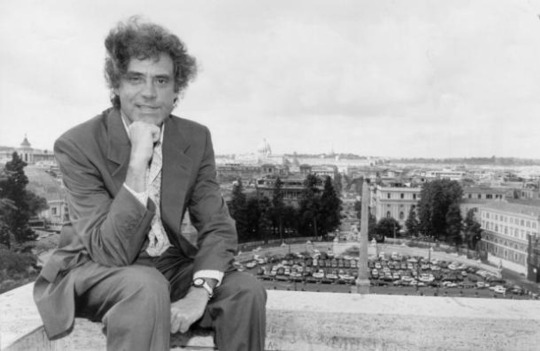
more notes:
[1] Luca Bergamo, Perchè siamo oltre l’Estate romana, La Repubblica 23/06/2020 leggibile online al seguente indirizzo: https://ricerca.repubblica.it/repubblica/archivio/repubblica/2020/06/23/il-nostro-obiettivo-oltre-leredita-dellestate-romanaRoma11.html
[2] Rimando per questo gioco di parole a Christian Raimo e all’articolo di Cecilia Gentile, Le polemiche sull’estate romana. Raimo:“scelte elitarie, periferie sole, roma grama! Pubblicato su La Repubblica il 22/06/2020 leggibile online al seguente indirizzo: https://roma.repubblica.it/cronaca/2020/06/22/news/la_polemica_sull_estate_romana_raimo_scelte_elitarie_periferie_sole_roma_grama_-259861196/
[3] Qui rimando al libro di Renato Nicolini, Estate romana. 1976-1985: un effimero lungo nove anni, Città del Sole, Cosenza, 2011.
[4] E qui basta riferirsi al fatto che Jack Lang, Ministro sotto Mitterand colpito dall’Estati romane nicoliniani, assegnò a mio padre il titolo di Chevalier de l’Ordre des Arts et des Lettres oltre che a dichiarare in più occasioni di essersi ispirato a Nicolini durante la sua mministrazione in particolare per la creazione della Fete de la Musique a Parigi.
[5] Espressione utlizzata da Filippo Celata in un articolo che sarà pubblicato sul numero 5/2020 di Micromega in edicola a partire dal 23 luglio.
[6] http://www.archiviocapitolino.it/eventi.php?page=4&eid=43
[7] Per avere una breve panoramica degli studi più recenti faccio riferimento ai seguenti testi: A.A.V.V. Massenzio ’77-’79. Tendenze urbane. Il programma completo della manifestazione, Castelvecchi, Roma 1997; A.A.V.V. Sentieri Selvaggi Magazine, Il desiderio di essere inutile. Renato Nicolini, l’intellettuale 2.0, Magazine n.3 settembre/ottobre 2012; Federica Fava in Federica Fava, L’Estate romana. Tempi e pratiche della città effimera, Quodlibet, Macerata, 2017; Guido Panvini et Ottavia Nicolini, ˂LL’Estate romana contro il terrorismo˃, Laboratoire Italien, 22, 2019 leggibile online al seguente indirizzo: https://journals.openedition.org/laboratoireitalien/2721; Camilla De Boni, Massenzio 1977-1985. Mito e poetica del meraviglioso Urbano, tesi di Dottorato in Paesaggi della città contemporanea, Università degli Studi di Roma Tre, Dipartimento di Architettura, A.A: 2018-19 di prossima pubblicazione presso la casa editrice Libria di Melfi.
[8] Maurizio Caprara, Coronavirus a Roma, da Nicolini un esempio per salvare la cultura publicato su Il Corriere della Sera, 24/04/2020 e leggibile al seguente indirizzo: https://roma.corriere.it/notizie/cronaca/20_aprile_24/modelloper-salvare-cultura-9852c4fe-857b-11ea-b71d-7609e1287c32.shtml?refresh_ce-cp
[9] Come ricorda Federica Fava in Federica Fava, L’Estate romana. Tempi e pratiche della città effimera, Quodlibet, Macerata, 2017, p.53
[10] “[…] Massenzio, come luogo dei concerti estivi dell’Accademia di Santa Cecilia, era invece un luogo considerato di élite, riservato ai colti e dunque ai pochi. Molti allora vi entrarono per la prima volta”, Renato Nicolini, L’architettura dell’immateriale, in Massenzio ’77-’79. Tendenze urbane. Il programma completo della manifestazione, Castelvecchi, Roma 1977, pp. 26-27
[11] L’espressione meraviglioso urbano è stata coniata proprio da mio padre per descrivere la sua Estate romana. Per saperne di più rimando al suo articolo Il meraviglioso urbano, pubblciato in L’effimero teatrale, alla puntata televisiva condotta da Gianni Minoli di La Storia siamo noi. Massenzio: meraviglioso urbano visibile a questo link: http://www.lastoriasiamonoi.rai.it/video/massenzio/1158/default.aspx
[12] Jack Lang, Prefazione, in Renato Nicolini, Estate romana. 1976-1985: un effimero lungo nove anni, Città del Sole, Reggio Calabria, 2011, p.16
[13] Roma.fanpage.it/il-significato-della-canzone-che-lucio-dalla-ha-dedicato-a-roma-la-sera-dei-miracoli/
[14] Per chi volesse approfondire il periodo dell’Estate romana rimando alla prossima iniziativa che si terrà a Casetta Rossa il 10/07/2020 dove nel coros della serata verrà proiettato il documentario „Ciao Renato!“ di Cristina Torelli, Paolo Luciani e Roberto Torelli a cui seguirà una tavola rotonda dedicata a Renato Nicolini e alla sua visione rivoluzionaria di città. Per maggiori informazioni rimando al seguente indirizzo: https://roma.repubblica.it/cronaca/2020/06/27/news/roma_un_mese_tra_incontri_musica_e_cucina_a_casetta_rossa_inizia_l_altra_estate-260381259/
https://www.quodlibet.it/recensione/2817
1 note
·
View note
Photo
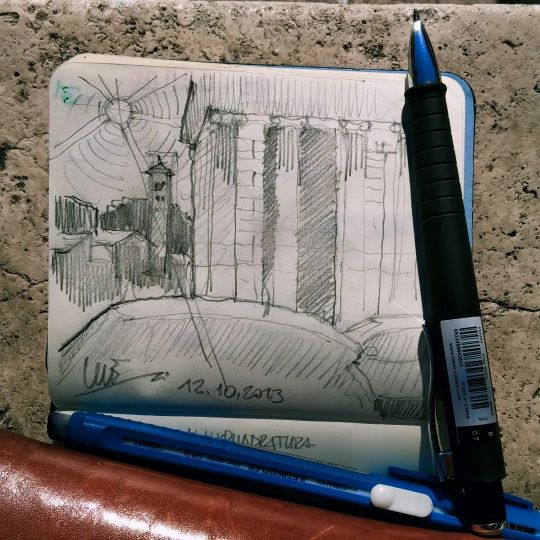
esci dall'anagrafe di #roma dove ho trovato un funzionario molto intelligente e cortese che non finirò mai rigraziare, giornatazza di sole, e che fai, uno #sketch al volo per imparare a proporzionare e disegnare il #controluce non lo fai? #matita#fabercastell #polymatic 0.7 che disegna da sola, fantastica! #luke_giallo💛 #luke_arancio🧡 #luke_blackandwhite🤍🖤 #roma #rome #italia #italy #sketching #disegno #disegnare #draw #drawing #bianconero #blackandwhite #disegnarematita #disegnareamatita #disegnomatita #drawingpencil #technicalpencil #disegnodiarchitettura #disegnoarchitettura #architetturadisegnata #drawingarchitecture #architetturaromana (presso Anagrafe, Via Luigi Petroselli) https://www.instagram.com/p/CojzDeNM32L/?igshid=NGJjMDIxMWI=
#roma#sketch#controluce#matita#fabercastell#polymatic#luke_giallo💛#luke_arancio🧡#luke_blackandwhite🤍🖤#rome#italia#italy#sketching#disegno#disegnare#draw#drawing#bianconero#blackandwhite#disegnarematita#disegnareamatita#disegnomatita#drawingpencil#technicalpencil#disegnodiarchitettura#disegnoarchitettura#architetturadisegnata#drawingarchitecture#architetturaromana
0 notes
Photo
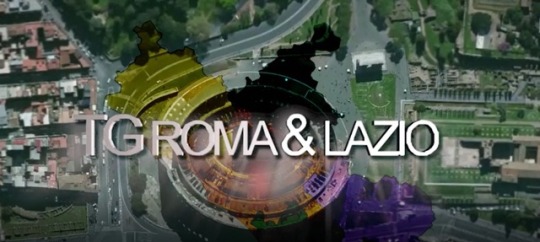
Il 25 aprile a Roma; l’Archivio storico capitolino si arricchisce con documenti Petroselli; a Guidonia primarie al veleno I titoli del Tg Roma e Lazio dell’edizione di oggi: A ROMA FESTA 25 APRILE TRA DIVISIONI, ECCO EVENTI ISTITUZIONALI…
#David Granieri#Fosse Ardeatine#Foto#Lazio#Luigi Petroselli#Marietta Tidei#Nicola Zingaretti#Regione Massimiliano Smeriglio#Roma#Virginia Raggi
0 notes
Photo
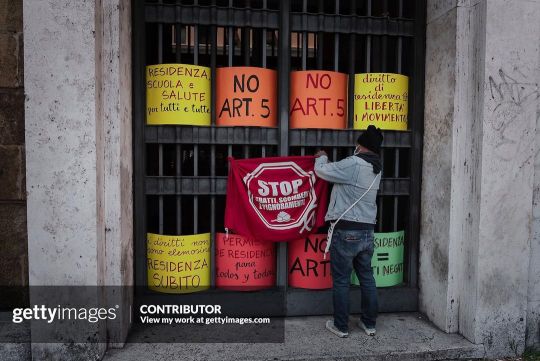
Protesters Call For Right Of Residence And Freedom Of Movement ROME, ITALY - APRIL 09: The entrance to the registry office covered by protesters' placards during the demonstration against Article 5 and to demand the right of residence and freedom of movement within and beyond the pandemic to Piazza della Bocca della Verità on April 9, 2021 in Rome, Italy. Since May 2014, Italy has had a rule in place that denies residency to people living in occupied properties used as housing. Article 5 of the law of 23 May 2014, which bears the signatures of the then Prime Minister Matteo Renzi and the then Minister of Infrastructure Maurizio Lupi, states that anyone squatting in a property without a title cannot apply for residency or connection of utilities. This law excludes thousands of people from the possibility of exercising their constitutionally guaranteed social, civil and political rights. (Photo by Stefano Montesi - Corbis/Corbis via Getty Images) #GettyImageContributor #documentaryphotography #photography #reportagespotlight #gettyimagesnews #gettyimagesitaly #photojournalism #StefanoMontesi #Rome #Italy #GettyImages #protest #COVID-19 #Politics #HumanRights #housing #evictions (presso Anagrafe, Via Luigi Petroselli) https://www.instagram.com/p/CNdPUAVnTjO/?igshid=wrgwttrdbgr6
#gettyimagecontributor#documentaryphotography#photography#reportagespotlight#gettyimagesnews#gettyimagesitaly#photojournalism#stefanomontesi#rome#italy#gettyimages#protest#covid#politics#humanrights#housing#evictions
0 notes
Text
Two Best Hotels in Trastevere Rome
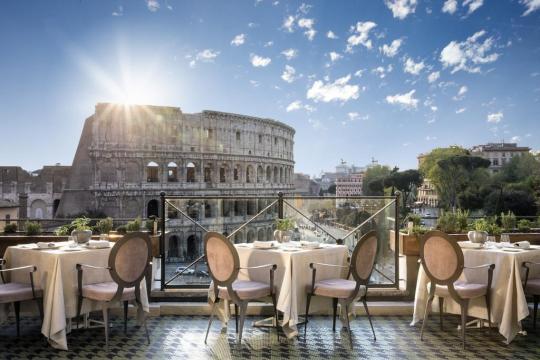
Trastevere is one of the prettiest neighborhoods on everyone’s must-see list when they arrive in the eternal city, Rome. With charming medieval alleyways, a thriving nightlife, and artisan workshops, there’s always something for every visitor. It’s narrow cobblestone streets, colorful buildings dripping with ivy, and balconies enlivened with geraniums were once a hidden gem in Rome, you won’t find anywhere else in the world, now visited by a good number of travelers every year. If you are looking for a hustle-bustle free location then Trastevere is decently quiet (at least by day), relaxed, and has far less traffic than other parts of chaotic Rome. It feels like a small town than a capital city and yet it’s conveniently located from the historic center, Vatican, and Colosseum all within a 30-minute walk. It’s a must to Wander around a Medieval church, admire 19th-century watercolors and dine on first-class pizza. Must explore L’Isola Tiberina, Museo di Roma in Trastevere, Almalu Trastevere, Polvere di Tempo, and Porta Portese flea market. While planning your trip we’ll suggest you do a little bit of research for Hotels in Rome to avoid any kind of hassle during your vacation.
If you are wondering about good budget-friendly accommodation? We have got you sorted to Best Hotels in Rome for your comfortable stay below!
Relais Casa Della Fornarina
Located at Via Di Porta Settimiana 7, Relais Casa Della Fornarina is a three-star property set in a historic building in picturesque Trastevere, next to Porta Settimana. Each room features free WiFi access and an LCD TV with satellite channels. Daily housekeeping service is provided without any fee. Rooms at this property are air-conditioned and have a minibar and a bathroom with a hairdryer. Some rooms serve city views, and some have garden views. This a perfect property for guests who enjoy independence as they receive the keys and a map of Rome at check-in. Guests can enjoy at the tea room available 24/7 that offers a selection of coffee, tea as well as snacks, and biscuits. Guests can also enjoy and get good use out of the shared kitchen equipped with a microwave, toaster, and fridge. Relais Casa Della Fornarina is set in Tan area filled with traditional restaurants, it’s just 300 meters from Santa Maria in Trastevere and a 10-minute walk from Campo dè Fiori square. Saint Peter's Square is within 20 minutes on foot.
47 Boutique Hotel
Located at Via Luigi Petroselli 47, 47 Boutique Hotel is a four-star accommodation with boasting a panoramic rooftop restaurant, and 1148 feet from the Bocca Della Verità sculpture. All the rooms at this property are Air-conditioned including a satellite LCD TV, and a mini-bar. The building also features a gym, steam bath, and rooms with parquet floors. The private bathroom features soft bathrobes, slippers, and a hairdryer. Wi-Fi is free throughout the hotel. Guests can kick start their day with an American breakfast served daily, including organic products, while creative Mediterranean cuisine is served at the restaurant. Guests also enjoy a cocktail at the 47 Circus Roof Garden bar, open when the weather is warm until 01:30. Teatro Marcello is 984 feet away, while the Jewish Ghetto is reachable on foot in around 5 minutes from the property.
So, these were the two finest Rome Hotels and will make your visit even more memorable.
Where to get the best deals and how to book hotels online? Explore TravOpedia where you can compare rates and amenities for different properties. You can read the reviews of the guest who stayed there in the past or look into the images of the properties or research over the location of the property on maps or even videos that will help you to judge your stay.
If you are also looking for Cheap Flights to Rome explore TravOpedia to get online promotional codes by exploring the web & that will help you save large.
0 notes
Text
Roma v’s Juventus
13/05/2018: It was a late start today as it was a late one last night and another late one expected tonight, watching Juve v Roma at Stadio Olimpico.
We had nothing planned so we wandered out the front door, veered left and kept to the footpath until reaching the traffic lights at the eastern end of the Coliseum. Straight across the road was Rome's foremost training academy for gladiators, Ludus Magnus. Built by Emperor Domitian in the late first century, the complex was just one part of a wider public building project undertaken by the Flavian emperors, however its closure came about five hundred years later when gladiatorial contests were abolished. Although only part of it was uncovered, it was enough to get a perspective of its size and layout. We weren't part of a tour but there were tours in the grounds. Still, a quick look from the top to appreciate the ruins was plenty.

Part of the Ludus Magnus, gladiator school with a tunnel linking it directly to the Coliseum. The rest is still buried under the streets and buildings
Negotiating the traffic was our first challenge for the day, negotiating the beggars on route to our next destination was the second. They were everywhere and driving us nuts already. Keeping the Coliseum, Arch of Constantine and Forum Romanum to our right, our next stop was along Via di San Gregorio and also to our right, Circus Maximus. Located in the valley between the Palatinus and Aventinus, another couple of Roman hills, the chariot circuit was apparently built during the sixth century B.C. by Tarquinius Priscus, the fifth king of Rome. Also apparently, it was while these races were underway at some point that the rape of the Sabine women occurred. The Sabine men were so engrossed in the races that the Roman men abducted their unmarried women to be their wives. Good story anyway.
We were at the round end, the square end was quite a distance away. Over half a kilometre where the chariots would enter the stadium twelve at a time, six on either side of the entry that led from the Forum Boarium. Sitting above the entry was the presiding magistrate who would be either a praetor or consul and started the race by dropping a white starting flag. We were overlooking the sweeping curve or sphendone where the Arch of Titus was located and where the processions would pass through to enter the arena. There's not much left now but some remnants of the arch's columns are still around. The complex once held well over a hundred thousand people but was now a grassed over reminder of the power of the Romans.
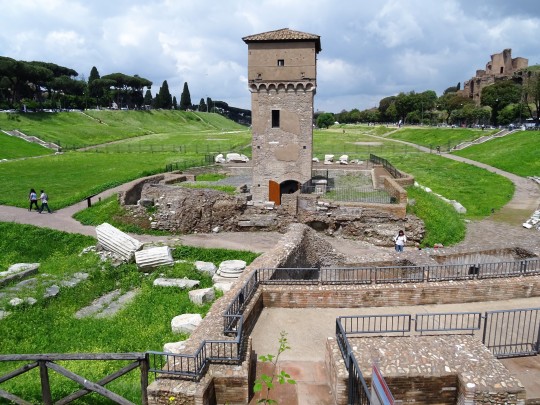
The tower of Moletta, a medieval water mill built after the Circus Maximus became farm land. The remains of another Arch of Titus bottom left. It was part of the original complex through which processions entered the arena
Down at the other end of Circus Maximus, near where the chariots would have entered was void of anything at all. The dirt track adjacent and parallel to Via di Cerchi, toward the square end of Circus Maximus (where all the chariot prangs apparently happened) led us there but we couldn't get all the way as it was blocked off, forcing us to move onto the footpath due to tents having been erected for the eighteenth Komen Italia Race for the Cure (breast cancer), due in five days’ time and filling up the end of the stadium.
It was then down to a busy and confusing area where traffic came from everywhere and cars parked all over the place. This was Forum Boarium where the chariots would have come from to start the races. To cross the main road we had to walk a bit to a pedestrian crossing (not that it's any safer), crossed Via Luigi Petroselli and walked up Via dei Ponte Rotto, behind the Temples of Portunus and Hercules Victor and across the Tiber via Ponte Palatino.
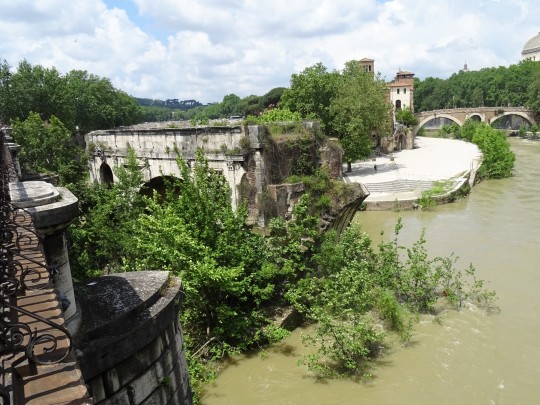
Ponte Rotto (Broken Bridge) was known by several different names during its existence. It kept collapsing and every time it was rebuilt it was renamed. All but one span was demolished to build the current bridge. Tiber Island and the oldest bridge in Rome, Pons Fabricius in the distance
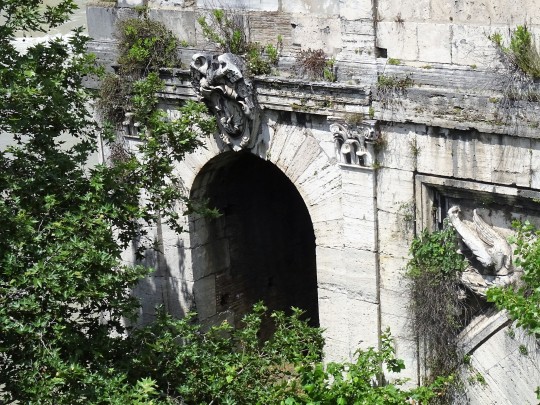
Coat of Arms of Pope Gregory VIII, pope for two months in 1187 was still there
The Tiber was interesting to say the least. Walking along the western promenade afforded a lovely view of the murky water and weir that ponded the murky water under Ponte Cestio, creating eddies that trapped litter and vegetation in what seemed to be a state of perpetual motion. The fascination of the spinning pollution soon became tedious so moving towards Ponte Cestio, we crossed the bridge and familiarised ourselves with Piazza di San Bartolomeo all'Isola where we would meet the guide for the food tour tomorrow. We then crossed the oldest Roman built bridge still in use, Pons Fabricius. The bridge was built during the first century B.C. linking Campus Martius and the Theatrum Marcelli to Tiber Island, named after its builder, Lucio Fabricius and adorned by two very weathered herms with four heads, hence its nickname, Ponte dei Quattro Capi.

Lvcivs FABRICIVS Cai Filivs CVRator VIARvm
FACIVNDVM COERAVIT EIDEMQVE PROBAVIT

Temple of Apollo Sosianus at the back. Theatre of Marcellus to the right
Heading up Via del Portico d'Ottavia, we were looking for a feed. It was after one and everyone was hungry. The entire street was packed with tourists with not much room alfresco. We ended up getting a table at Il Giardino Romano up against the front of the building. The food filled a hole but was expensive and somewhat ordinary.

Lunch at Il Giardino Romano. Tourists a plenty
With filled bellies we headed further along until we turned into Via Arenu'a and found a confronting reminder of the past. As we had encountered in Berlin a few years ago, a couple of brass plaques were imbedded into the footpath representing a couple of locals who were long gone. They were local Jews who would have been rounded up by the Fascists and sent off to the camps. They didn't muck around neither as they were transported fifteen hundred kilometres to Auschwitz and gassed within a week of their detention.
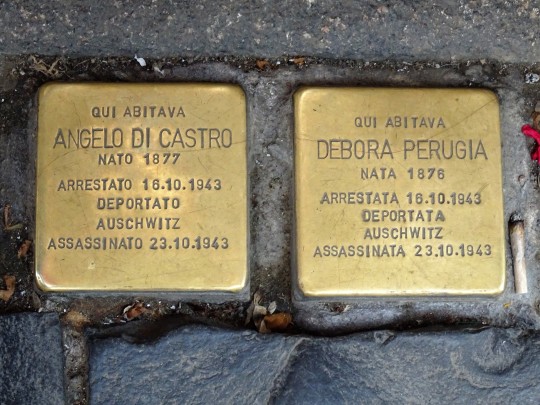
Just as in Berlin, the footpaths recognise Jews who were marched out of their houses to meet an early demise. This time it was Angelo and Debora's turn
On that depressing note we moved on and almost immediately came across Largo di Torre Argentina, named after a character from Strasbourg which at some time carried the Roman name Argentoratum. The ruins contained Roman Republican Temples and the remains of Pompey's Theatre. They also contained a few too many cats, although one cat is too many, and someone to feed them from a room within the ruins at the southern end. Tom and Beau were quite interested in them. But most others weren't.

Temple B, dedicated to Fortuna Huiusce Diei
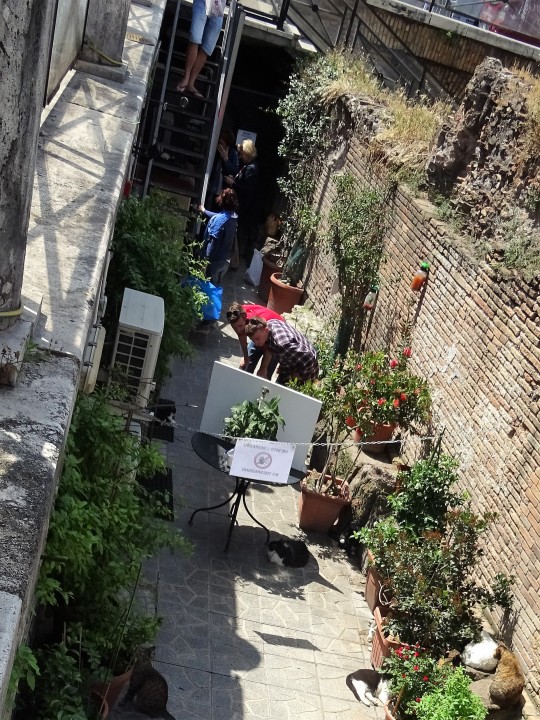
Here Kitty Kitty. The Torre Argentina Cat Sanctuary
Piazza Navona was a few streets away and our next stop. The area was filled with all sorts including faceless clowns and mimes but we particularly enjoyed the buskers, old guys playing stringed instruments and entertaining all who would get involved. There were also the usual Africans trying the usual and plenty of artists selling their stuff. At the other end of the piazza were more stalls and Fontana del Nettuno. Beyond the fountain was a short lane that led to gelato and a rest.
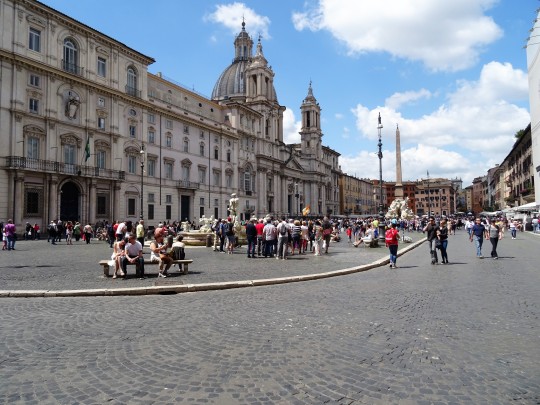
Piazza Navona, ex chariot track
Soon after zig zagging through a few more streets we entered Piazza della Rotonda just near Fontana del Pantheon. The place was packed from where we entered through to the queues waiting for entry into the Pantheon.
Monumental complexes and such started to spring up in this area following Octavian's (soon to become Emperor Augustus) victory over Marc Antonio and Cleopatra at the Battle of Actium off of the coast of modern day Preveza in Greece. The victory occurred in 31 B.C. and was effectively the final battle of the Roman civil war of the Roman Republic. From there on Octavian became Augustus, the first emperor of the Roman Empire. One of his initial projects was his magnificent Mausoleum, followed by the Pantheon a few years later. What we see today is a radically altered Pantheon constructed by Hadrian during the early second century.
There were as many people as expected. Several horse drawn carriages trying to entice tourists into a ride had to manoeuvre through the crowd by using their size, albeit politely. Queueing up with the crowd wasn't too bad as the lines moved fairly quickly but once inside the crowds were just as bad. Everyone going about their business, admiring everything and kinking their necks, looking up at the imposing dome and the equally imposing oculus well above. While we were there a mass was getting underway. It must have been difficult to perform but the priest was probably used to it. A rope barrier only allowed entry to the fair dinkum worshippers.

Chapel of the Pantheon
Back outside though, Tom and Beau were focusing on other matters. The old fella cutting prosciutto off the bone near the entrance to the salumeria.

Mulling over whether to buy some salumi
Trevi Fountain was next. Not being exactly sure where it was, we followed the crowd and the obvious narrow laneways that led a path to the again, crowded monument. Unlike most other monuments in Rome, the Trevi Fountain and Spanish Steps are quite recent, eighteenth century in fact which is almost new by Roman standards.
Everyone was taking their selfies and as crowded as it was we could still squeeze through to access the lower and closest tier and manage to grab some seating. Then, Cec goes down, flat on her arse on the worn and uneven marble steps. We sat her down for a while until she recovered somewhat and then hung around and enjoyed the atmosphere for a while, as much as we could anyway. Then, down a side street for food, across Via del Corso and further on to GiaRoma1886. It was quite hot but we chose al fresco so Cec could have a vape, sitting on the footpath across a small laneway where the waiters would carry our tucker whilst looking out for traffic. We were in the shade so it was quite comfortable bar the noise. GiaRoma1886 was a pretty good restaurant. It gave the appearance of being small on the outside but upon entry was quite large and well set out on the inside.
We then separated. Jo, Shane and Tom towards Piazza Picolo while Cec and Beau headed back to base.

Trevi Fountain
From there Piazza del Popolo was our focus and the tram stop beyond the gate. Several stops along the way were necessary to watch the street artists, some extremely good like the hip hoppers and the dude with the glass balls and others a bit strange. One that come to mind was the person inside the box with hand puppets that would jump out and scare the shit out of people as they walked past. He didn't get us so it was quite funny to watch everyone else's reactions. The final stop before moving through Porta del Popolo and outside of the Aurelian Walls was the Roma football shop. There was plenty to look at inside but we were only looking for something to wear at the football. A cap and scarf for the football and a cheap Roma v Liverpool T shirt left over from the recent Champions League semi final. Liverpool won so they would have been keen to get rid of them.
The tram terminus was straight outside of Porta del Popolo, across a couple of very busy roads and into Piazzale Flaminio. We were a bit early so we headed to Tintori for a quick beer. Plenty of Roma fans meant that there were no seats, they took them all. There were almost as many cops keeping the peace. We stood on the footpath leaning on the underground access to the Metro, drinking beer and enjoying the goings on until it was time to leave. This meant queueing for the toilet in the bar. Even the cops were queueing for a piss so we all headed next door to Burger King. Even they were busy.
Ending up on the tram platform, we just missed out on the next tram but were amongst the first to catch the following. Unlike the last time when we headed to Lazio v Inter Milan, we went a stop or two further on and got off at Piazza Mancini.

Packed like sardines
Not knowing where to head after leaving the tram, we followed the crowd across the Tiber where we found plenty of vendors selling merchandise, food, beer and those shots of coffee that the Italians seem to love. We were right outside of Stadio dei Marmi, a fascist era open air stadium built under the direction of Benito Mussolini to compliment the annexed Fascist Academy of Physical Education. From a distance the arena was surrounded by classical statues but ended up being fake Greco-Roman ones. We grabbed a panini and beer before heading around the entry point and to Curva Nord to take our seats.
The security were much more organised than when we watched Lazio and Inter Milan last time. There was still security and police but it was a smoother entry. Shane still managed to lose his bottled water again at the hands of a police frisking. Once inside there were a lot more kiosks open than at the Lazio game. The only issue was the piss trough cascade that was overflowing all over the floor before the game had even started and only got worse during the night.
Our seats were located a fair way down the concourse and almost behind the goals. We were fairly early but as kick off neared the crowd thickened around us. At first we bought the beers at the kiosk but as the game commenced a team of vendors walked around with beers delivered. They were more convenient and the plastic cups were bigger. A win, win situation.
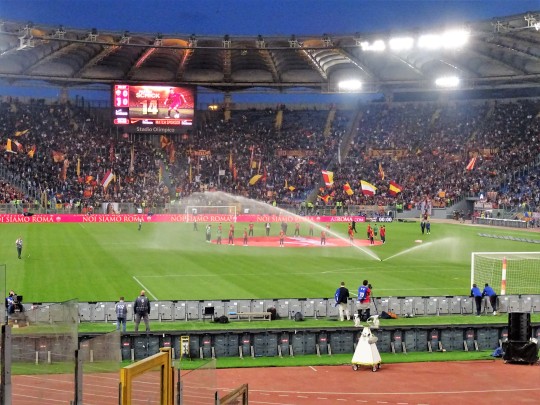
Pre match introductions
The atmosphere was excellent and although amongst Roma fans, we were at the same end as the Juventus fans. A point would have given Juventus the premiership. They were very rowdy and whatever they were chanting, the Roma fans around us would scream an emotional response of some sort. As if they could be understood.
The game ebbed and flowed with chances at both ends. It however ended scoreless which meant that Juventus had got what they had come for, a point. The only team that could have beaten them was Napoli who had won earlier and their score went up, on the score board. Everyone knew what was happening. The Serie A was in the bag.

Post match. Juventus players thanking their supporters
After full time the boys challenged the toilets again and we headed out, walking back across Ponte Duca D'aosta. It was full of vans selling beers and steak sangers. Tom grabbed a largey and we headed off down the street. Not wanting to take the tram home we walked well away from the venue until we hailed a taxi. First thing he said was that the beer had to go. After that it was straight back to the apartment.
It had been a long day. When we had arrived back Cec and Beau had just got back from a session down stairs and were quite rowdy.

A few reds and ice cream to finish the night off
A couple of more drinks and it was bed. Tomorrow an early one at the Vatican.
0 notes
Text
Il sindaco Petroselli online su AAMOD dal 27 settembre
Il sindaco Petroselli online su AAMOD dal 27 settembre
IL SINDACO PETROSELLI
Il documentario di Andrea Rusich sul sindaco più amato di Roma, realizzato da un’idea di Paolo Masini, online dal 27 settembre. I materiali provengono dall’Archivio Audiovisivo del Movimento Operaio e Democratico
In occasione del quarantennale dall’elezione di Luigi Petroselli a Sindaco di Roma, l’Archivio Audiovisivo del Movimento Operaio e Democratico
View On WordPress
0 notes